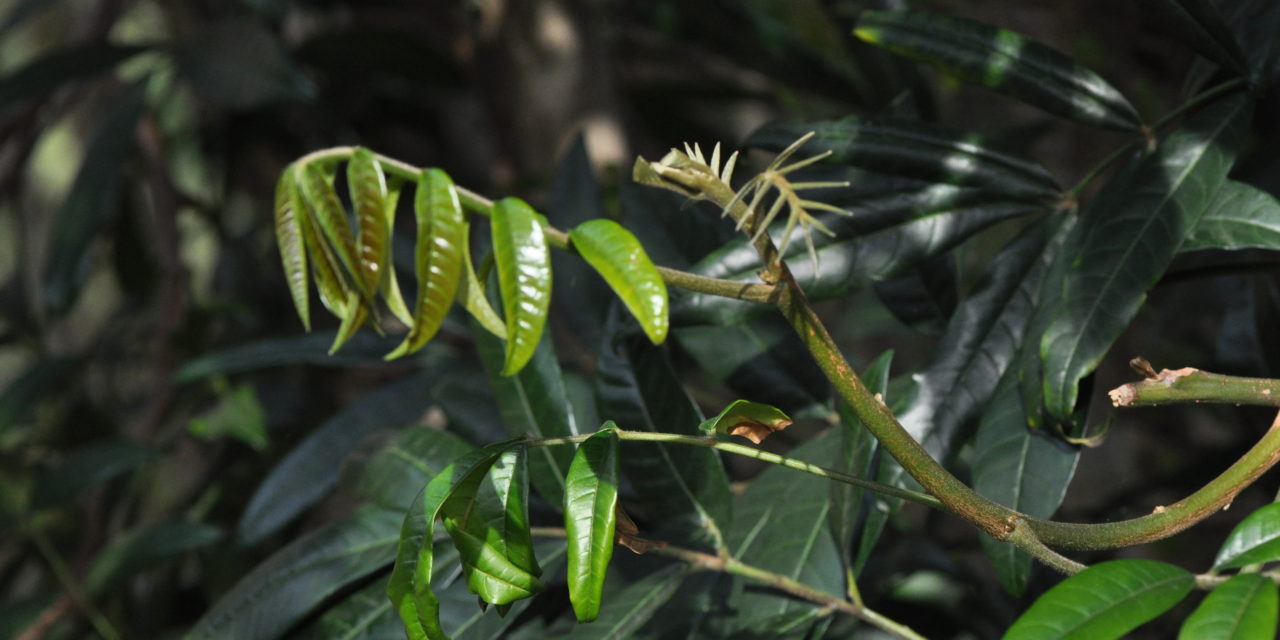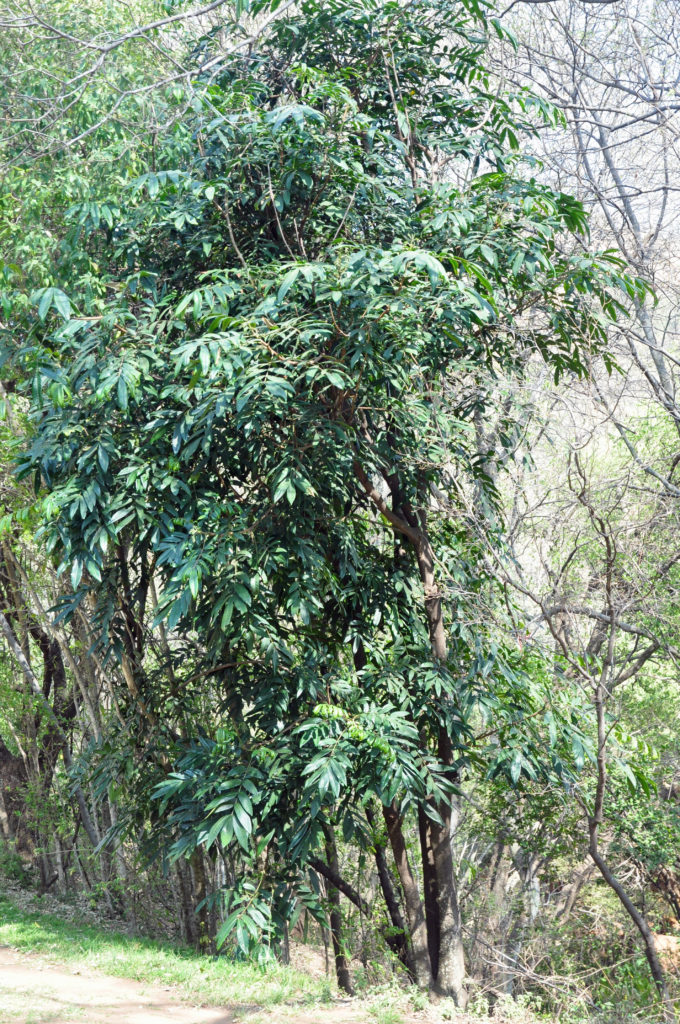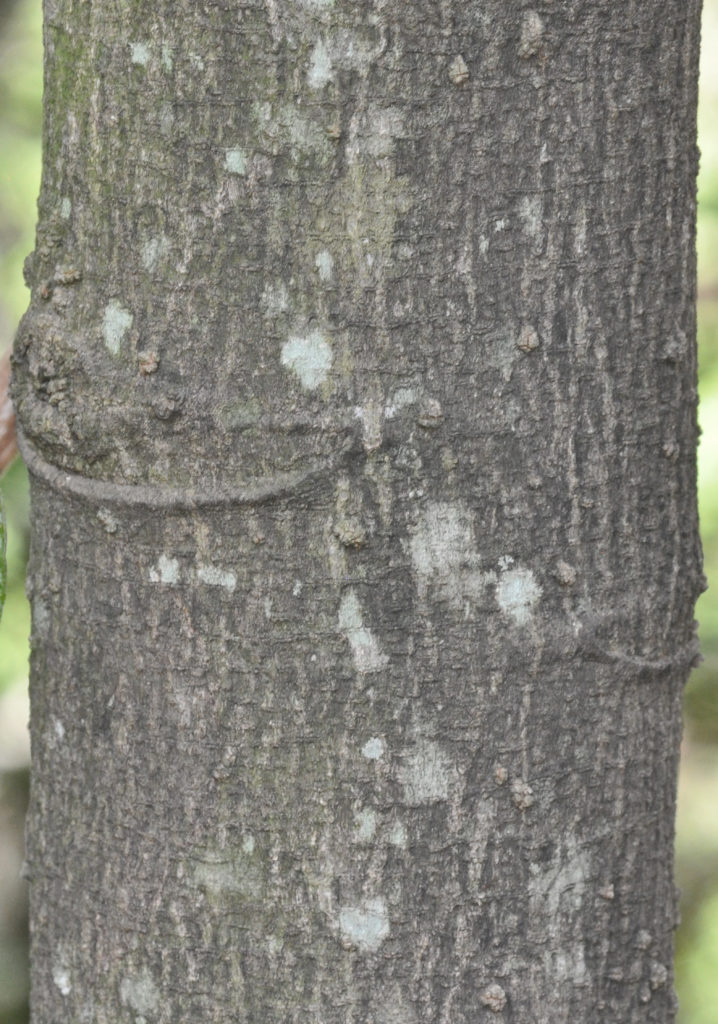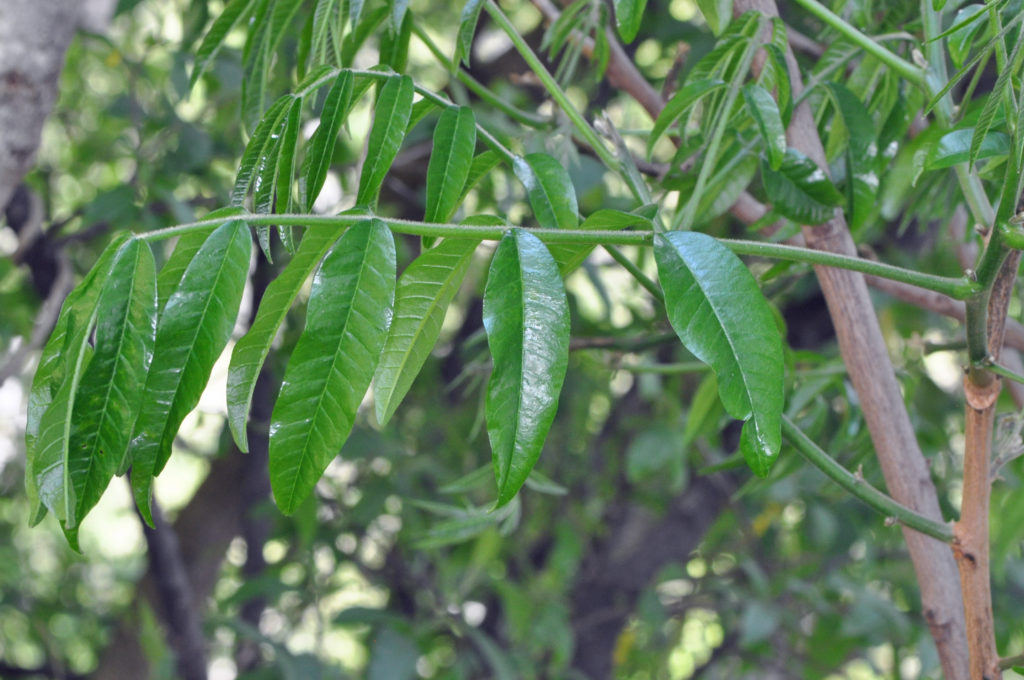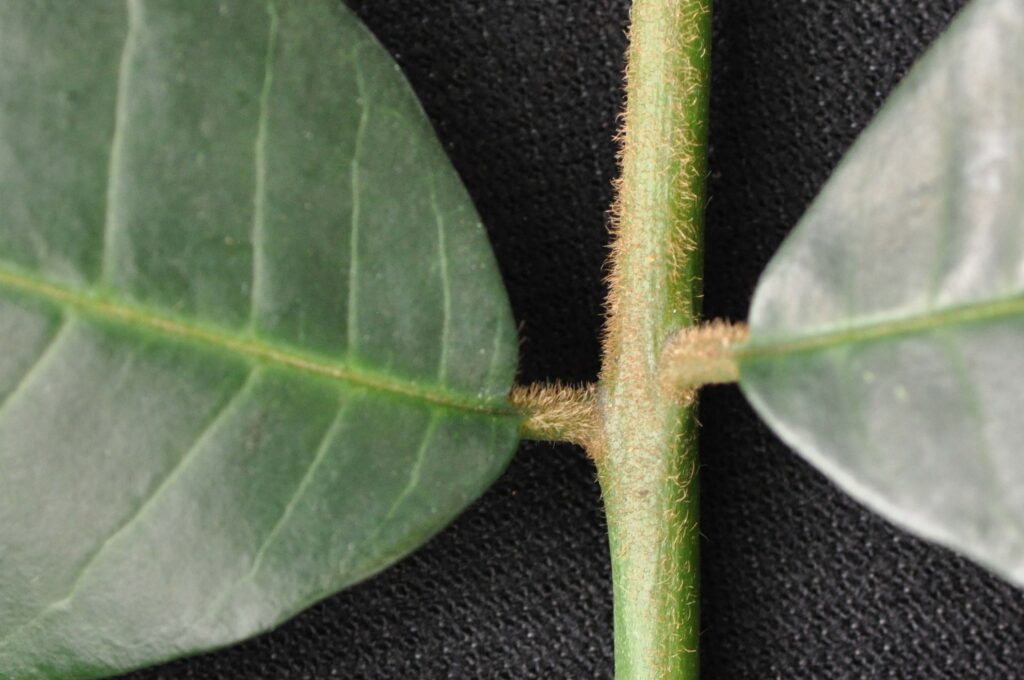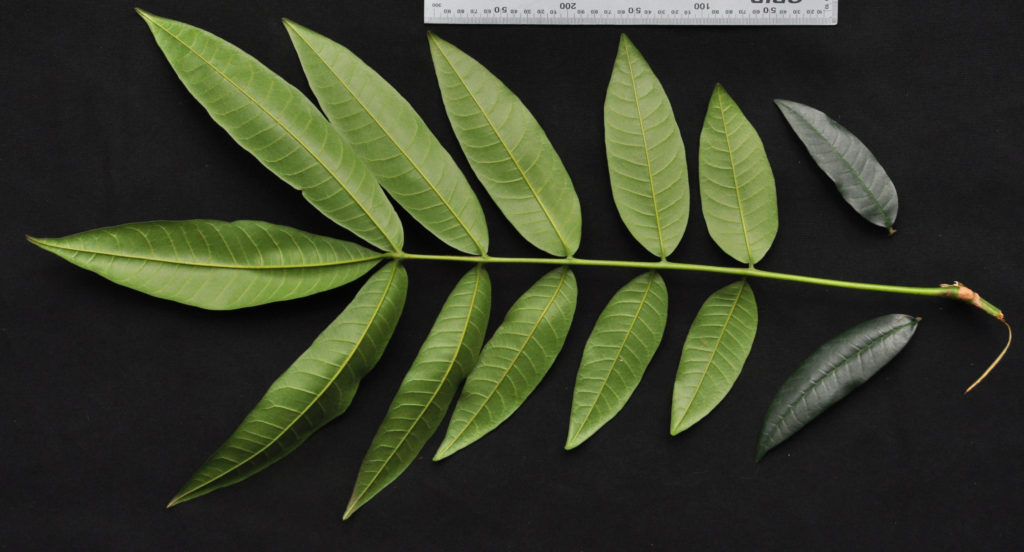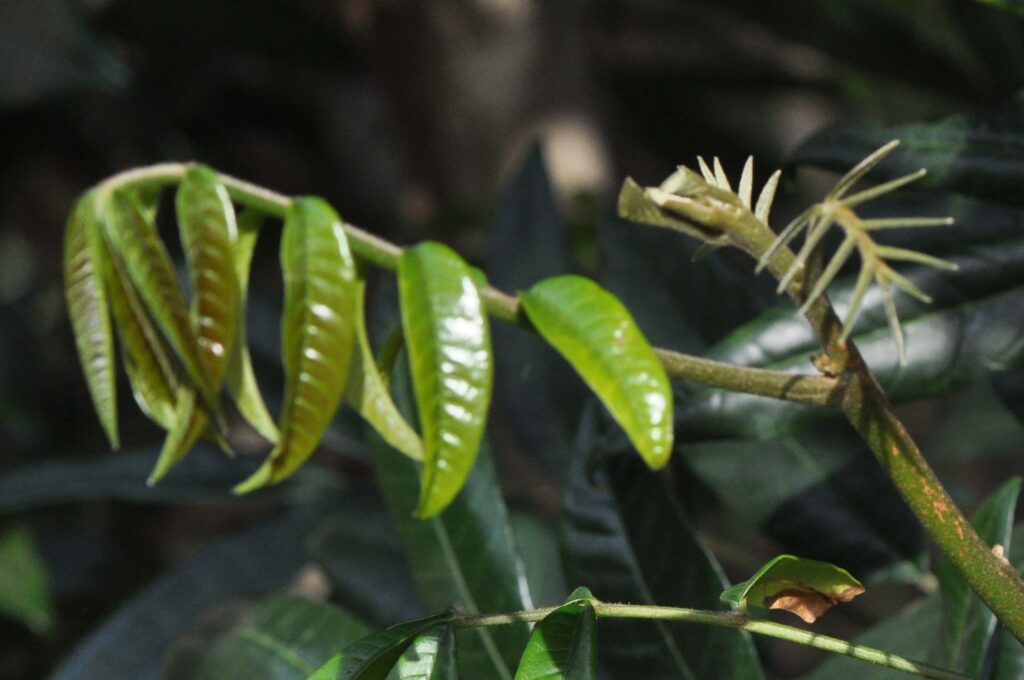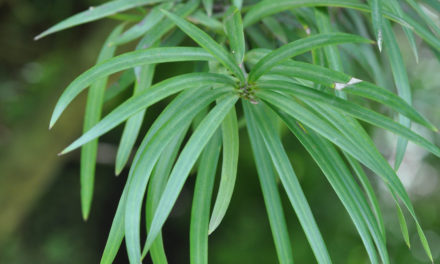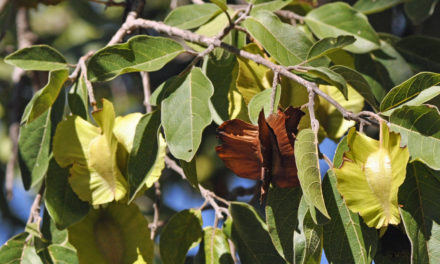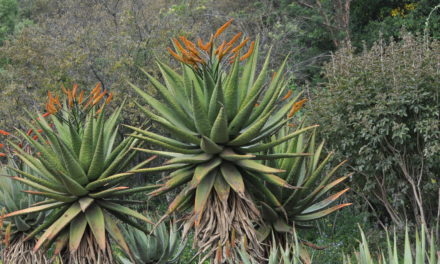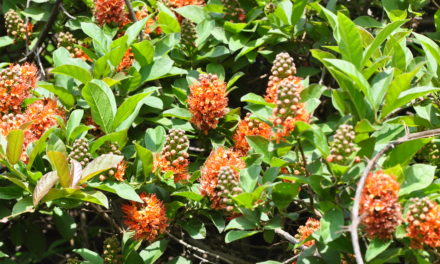General Info – summary
This dioecious Tree with its spreading crown is up to 30m high & the trunk to 1,8m wide. In this evergreen tree, the large Leaves are imparipinnate and lack stipules. The large whitish 5-merous regular Flowers are in panicles with 10 stamens in the male flower & a single pistil arises from a superior ovary in the female flower. Fruit is a roundish dehiscent woody capsule with each fatty black seed containing a scarlet aril.
Description
Trichilia dregeana
Previous Names: Trichilia chirindensis, Trichilia dregei.
SA No. 300.
Common names. (Afr) Basteressenhout, Bos Rooi-essenhout, Rooiessenhout, Bosrooiessenhout. (Eng) Cape Mahogany, Forest Mahogany, Forest Natal Mahogany, Thunder tree, Christmas bells, Red ash, Forest Natal Mahogany, White Mahogany. (isiXhosa) Umhlakele, Umkhuhlu, Umkhuhlwa. (isiZulu) Umantunzini, Umathunzi, Umathunzini, Umkhuhlu. (Northern Sotho) Mmaba. (siSwati) umKhuhlu. (Tshivenda) Mutshikili, Mutuhu.
Family Meliaceae (Mahogany family). This family of mainly shrubs and small trees has 50+ genera and 570+ species. Most members are trees or shrubs. Perhaps the best-known local alien tree in this family is the seringa (The scientific name is Melia azedarach) with its poisonous yellow berries. This tree is considered invasive in South Africa. In southern Africa, there are about 6 genera and 11 species. Those genera with trees include Ekebergia, Nymania, Khaya and Trichilia. Most trees are evergreen and Leaves are large, usually pinnately compound or simple, lack stipules and are usually alternate. They occur in a large cluster or on short shoots. The bisexual or unisexual Flowers are regular, axillary and in panicles (indeterminate, branched inflorescence with stalked flowers) or solitary. The Calyx has 4-5 sepals, which are free to near the base. The Petals are imbricate (having regularly arranged, overlapping edges). The 5 to many Stamens are free except at the base and the Anthers where they are dorsifixed (attached in the centre of the filament). The superior Ovary has a simple Style, which ends in a disc-like, head-like or lobed Stigma. The Fruit is a capsule or a drupe and may be winged or have a pulpy covering.
Name derivation: Trichilia – in 3 parts (referring to the 3-lobed fruits). dregeana – refers to Johan Franz Drege. He was a German botanist who visited South Africa between 1826 and 1834. His story is worth reading about. He collected over 200 000 specimens in 8 000 different species, including this tree. There are 2 species of the genus Trichilia in the South Africa. The other one is T. emetica.
Conservation: National Status: L C (least concern). Assessment: 2008 (V.L. Williams, D. Raimondo, N.R. Crouch, A.B. Cunningham, C.R. Scott-Shaw, M. Lötter and A.M. Ngwenya).
Tree
With its dense spreading crown, this Tree (photo 889) may reach 35m and occasionally 40m in height. The straight Trunk has a diameter up to 2m and develops a slightly buttressed base. Bark is smooth and grey to black (photo 257) with a rougher base that may be mottled with pink. This photo shows whitish coloured patches indicating the presence of harmless lichen (a composite organism arising from a mutualistic relationship between fungi or cyanobacteria and algae species).
- 889. 2016/09/06. Walter Sisulu NBG. Photo: David Becking.
- 257. 2014/10/07. Walter Sisulu NBG. Photo: David Becking.
Leaves
This evergreen tree has large, leathery, untoothed Leaves that are imparipinnate (pinnately compound leaf ending in a single leaflet – photo 310). The leaves are long – up to 28cm long (Photo 310). The well-spaced apart Leaflets are large – up to 21 x 9cm (usually smaller) and there are 3 to 5 pairs of usually opposite (photo 310) or alternate leaflets in additional to the terminal one. The paired leaflets are biggest near the leaf apex (photo 310). Yong leaflets are bright green and folded along the midrib (photo 503). Leaflets have 7-12+ pairs of widely spaces side veins – photo 310 (usually less than in Trichilia emetica). Leaflets are dark glossy green above (photo 259) and lighter below (photo 310). The Margin may be hairy and is entire (with a continuous margin, not in any way indented) and may be broadly rolled under. The Midrib and most lateral veins are prominent. They protrude below and are sunken above (photo 310). The Apex usually tapers to a point. The Base is rounded, narrowed or tapering. The leaf Rachis (the main axis bearing leaflets) is hairy (photo 312). The Petiole (leaf stalk) is up to 15cm long and the base is thick (photo 310). The Petiolule (leaflet stalk) is thick, up to 1cm long and may be hairy (photo 312). Stipules (basal appendages of the petiole) are absent.
- 259. 2014/10/07. Walter Sisulu NBG. Photo: David Becking.
- 312. 2016/02/23. Walter Sisulu NBG. Photo: David Becking.
- 310. 2016/02/23. Walter Sisulu NBG. Photo: David Becking.
- 503. 2016/08/16. Walter Sisulu NBG. Photo: David Becking.
Flowers
This tree is dioecious (unisexual floral structures with male and female parts on separate plants). The pleasantly scented and inconspicuous Flowers occur in Cymose (a cyme is a broad, more or less flat-topped, determinate flower cluster, with central flowers opening first) Panicles (indeterminate, branched inflorescence with stalked flowers). The pale yellow to green flowers are borne in leaf axils or are terminal. Flowers are large, creamy white, unisexual and up to 2,5cm long. They are actinomorphic (Regular, symmetrical. Flowers are vertically divisible into similar halves by more than one plane passing through the axis). The Calyx has 5 Sepals. The Corolla has 5 imbricate (having regularly arranged, overlapping edges) and the velvety Petals that are up to 2,5cm long. The Disc (a more or less fleshy or elevated development of the receptacle) is fused to the base of the staminal tube.
In the Male flowers, the 10 Stamens are fused near the base of the Filaments (stalks supporting the anthers). In the Female flowers, there is a single Pistil (a unit of the Gynoecium, the female element of the flower, composed of the Ovary, Style and Stigma). The superior Ovary is villous (provided with long and soft, not matted hairs). Each of the 2-4 Locules contains 1 or 2 Ovules. The villous Style (more or less elongated part of the pistil situated between the ovary and the stigma) is circular in cross section and the Stigma (the part of the pistil that receives the pollen) is capitate (formed like a head). (Oct-Dec).
Fruit
The pale, 3-lobed, green or purple, woody Fruit is up to 5cm in diameter and, apart from the indented tip, is an almost spherical and dehiscent Capsule (a dry fruit resulting from the maturing of a compound ovary that usually opens at maturity by one or more lines of dehiscence). Capsules occur in compact bunches. Each usually has 2-4 (usually 3) valves (separable parts of a pod; the units or pieces into which a capsule splits or divides in dehiscing). The fruit is velvety and lacking a distinct neck joining it to the stalk. The capsule dehisces – revealing 1 or 2 Seeds each with a bright red to scarlet fleshy aril (appendages or outer covering of a seed and may appear as a pulpy covering. It develops from a stalk, the funiculus, connecting an ovule and later the seed with the placenta). Arils almost surrounds each black Seed with high fat content. (Dec-May).
Distribution & Ecology
These Trees are common in moist evergreen coastal and montane forests and in high rainfall areas up to an altitude of 1 220m – often on mountain slopes. Location: From Eastern Cape, KwaZulu-Natal (Mitchell Park has one of the largest trees), Limpopo, Mpumalanga, North West Province, Swaziland, Zimbabwe, West side of Mozambique, Angola, DRC, Kenya, Tanzania and Ethiopia. This tree is frost sensitive. In order to stop harvesting of this species from the natural forest in Uganda (where the availability of trees is rapidly, decreasing), authorities have decided to make an effort to provide seedlings to local communities so that they can grow them on their farms. (This is similar to the action being taken for the pepper bark tree, Warburgia salutarus, in Mpumalanga). Many birds eat the seeds, including the Purple Crested Turaco (Tauraco porphyreolophus), which is the national bird of Eswatini (Swaziland). Charaxes brutus natalensis butterfly larvae feed off this plant as well as off Trichilia emetic, Ekebergia capensis and others. Seeds contain limonoid – an Antifeedant (an organic compound produced by plants, which inhibit attacks by grazing animals and insects. Baboons consume seed arils.
Ethnobotany
The Wood polishes well, is initially pink, turning a darker colour when oiled, and makes good furniture. Uses include carving of headrests, dishes, for carving, making of traditional musical instruments and canoes. This is a good general-purpose timber but needs to be treated against borer attack. The wood is also used for making household implements and bats. The fatty Seeds are utilized for the industrial production of pharmaceutical products, and for cosmetics, cooking, making candles and soap. After the removal of the seed coats, the seeds are edible. Seeds tend to germinate well – if planted soon after they develop. This is good shade tree, in a frost-free area, but is not for small gardens. Parts of the Bark are toxic and used for the preparation of fish poison. The bark has emetic properties. People, bats and birds eat the fruit. Arils are used to Local medicine that makes much use of tree parts, especially the bark.
References
Boon, R. 2010. Pooley’s Trees of eastern South Africa. Flora and Fauna Publications Trust, Durban.
Burrows, J.E., Burrows, S.M., Lotter, M.C. & Schmidt, E. 2018. Trees and Shrubs Mozambique. Publishing Print Matters (Pty) Ltd. Noordhoek, Cape Town.
Coates Palgrave, M. 2002. Keith Coates Palgrave Trees of Southern Africa, edn 3. Struik, Cape Town.
Ginn, P.J. McIlleron, W.G. Milstein, S. 1989. The Complete Book of Southern African Birds. Struik Publishers (PTY) LTD. Third impression 1991.
Lawrence, G. H. M, 1951. Taxonomy of Vascular Plants. The Macmillan Company, New York. Tenth Printing 1965.
Palmer, E. & Pitman, N. 1972. Trees of southern Africa. Balkema, Amsterdam, Cape Town.
Schmidt, S. Lotter, M. & McCleland, W. 2002. Trees and Shrubs of Mpumalanga and the Kruger National Park. Jacana, Johannesburg.
van Wyk, B. & van Wyk, P. 1997. Field guide to Trees of Southern Africa. Struik, Cape Town.
Williams, V.L., Raimondo, D., Crouch, N.R., Cunningham, A.B., Scott-Shaw, C.R., Lötter, M. & Ngwenya, A.M. 2008. Trichilia dregeana Sond. National Assessment: Red List of South African Plants version 2020.1. Accessed on 2024/02/16.
http://www.plantzafrica.com/planttuv/trichildreg.htm
http://www.zimbabweflora.co.zw/speciesdata/species.php?species_id=133560
https://en.wikipedia.org/wiki/Trichilia_dregeana
http://tropical.theferns.info/viewtropical.php?id=Trichilia+dregeana
http://posa.sanbi.org/flora/browse.php?src=SP
https://www.britannica.com/plant/Meliaceae
https://en.wikipedia.org/wiki/Johann_Franz_Dr%C3%A8ge

